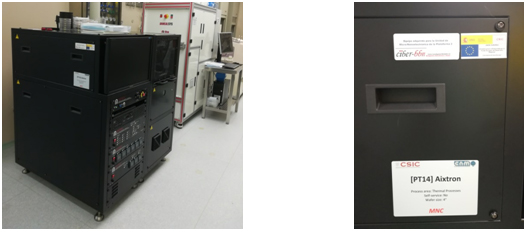U3-E05. Bohdan miniblocks
Bohdan miniblocks to generate libraries of medium- sized peptides.
Bohdan miniblocks to generate libraries of medium- sized peptides.
Analytical high-performance liquid chromatography (HPLC -MS ) system with a diode array detector and coupled to a mass spectrometer.
Analytical and prepartive high-performance liquid chromatography (HPLC ) system with dual-wavelength UV detector.
Analytical and prepartive high-performance liquid chromatography (HPLC ) system with a diode array detector.
Automatic synthesizer which can be operated at a range of scales (0.1-0.5 mmol) and with different types of chemistry (Fmoc and Boc) and coupling agents.

The CVD machine grows both single and multiwalled carbon nanotubes, using both plasma-enhanced CVD (PECVD) and/or thermal CVD. It enables the production of advanced CNT Micro-Nano-Bio Systems (MNBS) for biological, chemical or biochemical analysis. As the suitability of the interface of any MNBS device is a critical point, the selective growth of CNT improves the electrode-electrolyte interface enhancing the biomonitoring.
Its specifications are:
›› Heat processing control up to 900ºC, with controlled ramps of up to 300ºC/min.
›› Plasma control; completely configurable source. Possibility of working without plasma.
›› Camera for 4” wafers.
›› Camera for following the process.
›› Possibility of processes in high vacuum (5 mBar) and at atmospheric pressure (800 mBar).
›› Process gases: hydrogen, methane, acetylene, argon,
ammonium and air.
See
Complete electrochemical and electrical characterization of microelectrode arrays in either rigid or flexible substrates.
Customer benefits
Adaptable platform for electrical characterization of microelectrodes to meet customer needs
Target customer
Research groups and SMEs
References
Design and fabrication of microelectrode arrays in either rigid or flexible substrates.
Customer benefits
Target customer
Research groups and SMEs
References
The Advising and consulting in micro and nanofabrication service of U7, provides full support in the design of micro and nano fabrication processes for obtaining biomedical devices. We request deep information about the final application, technical needs, limitations, requirements, etc. and design, together with our clients, the best strategy for their fabrication projects.
Customer benefits
Our Advising and consulting in micro and nanofabrication service, benefits from being part of a bioengineering-specialized research centre, providing wide knowledge in the main applications and a large experience in the fabrication of biomedical devices in the field of bioengineering with different techniques and materials. We offer custom services, assuring close and direct interaction with the client, to meet conclusive results and high-quality needs.
Target customer
Our target customers are researchers in the field of bioengineering, or R&D departments of biotech companies which want to fabricate their custom biomedical prototypes or devices.
The Thin Film Deposition service of U7, allows the integration of microelectronics in biomedical devices. Having four different deposition sources, being resistive evaporation, electron beam evaporation, DC sputtering and RF sputtering, this is a versatile equipment, due to the wide range of deposition techniques and materials available (Ti, Cr, Cu, Au, Al, ITO, SiOx and AlOx).
Customer benefits
Our Thin Film Deposition service benefits from being part of a bioengineering-specialized research centre, providing wide knowledge in the main applications of these methods and materials in the field of bioengineering. We offer custom services, assuring close and direct interaction with the client, to meet conclusive results and high-quality needs.
Target customer
Our target customers are researchers in the field of bioengineering and microelectronics, or R&D departments of biotech companies which want to test include microelectronics in their biomedical prototypes or devices.
Additional information
Sputtered gold electrodes (100 nm thick), on a cover slip glass substrate. Image given by Dr. Mònica Mir from the “Nanobioengineering group” at IBEC.
